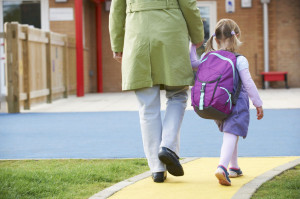 There are a few things that go hand-in-hand with school: pencils, notebooks and yes, backpacks.
There are a few things that go hand-in-hand with school: pencils, notebooks and yes, backpacks.
How many times have you seen a child walking to school with a backpack that seems to be bigger than them? Unfortunately, heavy backpacks can do a lot of damage to kids’ backs. Consistently carrying a backpack taht’s too large or too heavy can lead to lower and upper back pain, shoulder and neck strain and bad posture. Narrow straps can also cause tingling and weakness in the arms and hands.
While we can’t help to reduce the number of books and supplies your children are responsible for carrying, we can provide tips that you can pass on to your little ones to help lighten their load.
Find the right backpack. Your child’s backpack should not be wider than your child’s torso or hang more than 4 inches below the waist, according to the National Safety Council. Look for one with padded and adjustable shoulder straps and a padded back. Waist and chest straps can help to distribute the weight of the backpack more evenly.
Limit items. Studies show that it’s best for young kids to carry no more than 10-15% of their body weight in their backpack, so limit how many items you have them bring from home. Knowing that they will be required to have textbooks, notebooks, and other classroom supplies, hold onto what you can for them. Maybe this means meeting them on the field after school with their sports gear or budgeting in lunch expenses so they don’t have to carry around their lunchbox. Talk to your child’s teacher(s) or principal to help find ways to reduce the weight of your child’s backpack.
Use a locker. Another great way to take away some of the back burden is to encourage your child to use their locker, making the visit there between classes (if able) so they are only carrying what they need for the class they are on their way to. Sure, this may mean less interaction with their friends between class periods, but it’ll also mean that their back doesn’t suffer from unnecessary weight.
Wear backpacks properly. Your child’s use of their backpack and the posture they take on when wearing it makes a major difference too. Both straps should be worn, and they should be kept tight so the shoulders aren’t being dragged down. Bags should also be packed correctly so weight is distributed evenly to both shoulders. Lastly, practicing correct posture will keep the strain of the load from affecting the spine as much.
For more information about selecting the right backpack and wearing it properly, check out these tips from the National Safety Council.








